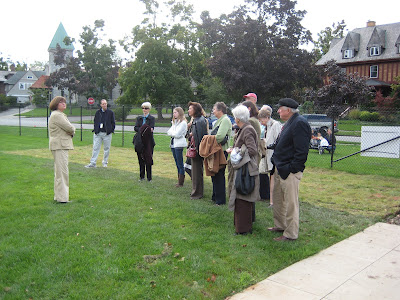The idea: I feature an item sold, lost or stolen from the Martin House (at some point in its past), and you, sleuths and Wright aficionados that you are, respond to let us know if you have any information on the whereabouts of such items.
This week: Martin House sconces


 Frank Lloyd Wright designed custom light fixtures for the Martin House, comprised of a glass globe suspended in an intricate, bronze bracket. Dozens of these fixtures were specified, fabricated and installed in the Martin House, c. 1905. The sconces came in two major types: "short stem" and "long stem" variations. The "short stem" sconces were installed on walls and possibly in a few outdoor locations, while pairs of "long stem" sconces emanated from each side of the pier clusters (see detail of the Fuermann photo above).
Frank Lloyd Wright designed custom light fixtures for the Martin House, comprised of a glass globe suspended in an intricate, bronze bracket. Dozens of these fixtures were specified, fabricated and installed in the Martin House, c. 1905. The sconces came in two major types: "short stem" and "long stem" variations. The "short stem" sconces were installed on walls and possibly in a few outdoor locations, while pairs of "long stem" sconces emanated from each side of the pier clusters (see detail of the Fuermann photo above).With so many of these sconces originally in the Martin House, it's curious that so few of them have come to light. Only two have made their way back to the Martin House collection, and two others have appeared on the auction block in recent years. These fixtures were certainly among the most easily removed parts of the house, but their scarcity today begs the question of whether there may be a large repository of them somewhere in the world, or whether they are rusting in attics and basements in Buffalo, Chicago or Wasilla.
Who knows? - maybe some of them were scrapped for the War effort in the forties, or melted down and recast into equestrian sculpture or Olympic medals.
If you can help prove or refute any of these fanciful theories, please contact us!








